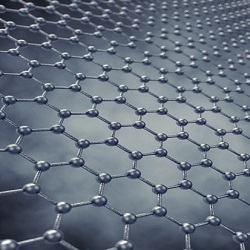I have developed a faster and more reliable way of measuring how molecules cross graphene membranes. As the thinnest possible membrane I’m interested in how we can exploit its unique properties for medical diagnosis, protecting smartphone screens or filtering water to give clean drinking water.
Although Graphene is a single atom thick its tight weave prevents any molecules from passing through it. To exploit this I have developed a way of sealing a piece of graphene over the end of a thin glass tube in much the same way a piece of cling film seals a glass jar.
Graphene is extremely strong but at the atomic scale this means that very small forces will damage it; so we float the graphene on water. I then push a glass tube which has been pulled to a very small diameter into the graphene. This isolates a small area of the graphene sheet between two reservoirs of water.
But if graphene is impermeable to all molecules how can I measure what can go through it? Each graphene atom should join to 3 others to form a hexagon structure. Sometimes this goes wrong and there are tiny gaps, like pin holes in cling film. These gaps can allow individual molecules to sneak through.
I hope to be able to tune the size of the gaps in the graphene by removing a handful of graphene atoms using chemical etching or firing fast particles at it to knock carbon atoms out. The resulting nanopores will be used to study nanopore sensing using graphene membranes. This opens up exciting opportunities in medical diagnosis. Many important biological molecules, such as DNA and proteins are a few nanometres across. If we can create pores in our membrane which very closely match the size of these molecules then we can detect when they pass through these holes as they will block the flow of smaller charged molecules carrying a current. From the way in which they block the current we hope to be able to identify and interpret information about the molecule. Graphene has the advantage that it is much thinner than the molecules are long, this increases the amount of information we can extract. This could be useful for detecting and diagnosing disease.
Studying graphene as a membrane material is an exciting field because the atomic thickness of the membrane promises performance that cannot be achieved with other membrane materials but working with such a thin membrane presents many challenges.
Michael Walker
NanoDTC PhD Student Cohort 2012
Biological and Soft Systems Group, PhysicsHofmann Group, Engineering

